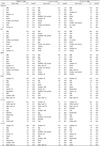1. Srinivasan SR, Frontini MG, Xu J, Berenson GS. Utility of childhood non-high-density lipoprotein cholesterol levels in predicting adult dyslipidemia and other cardiovascular risks: the Bogalusa Heart Study. Pediatrics. 2006; 118:201–206.

2. Wu TC, Chen PH. Health consequences of nutrition in childhood and early infancy. Pediatr Neonatol. 2009; 50:135–142.

3. Sioen I, van Lieshout L, Eilander A, Fleith M, Lohner S, Szommer A, Petisca C, Eussen S, Forsyth S, Calder PC, Campoy C, Mensink RP. Systematic review on n-3 and n-6 polyunsaturated fatty acid Intake in European countries in light of the current recommendations - Focus on specific population groups. Ann Nutr Metab. 2017; 70:39–50.

4. Abedi E, Sahari MA. Long-chain polyunsaturated fatty acid sources and evaluation of their nutritional and functional properties. Food Sci Nutr. 2014; 2:443–463.

5. Calder PC. Functional roles of fatty acids and their effects on human health. JPEN J Parenter Enteral Nutr. 2015; 39:18S–32S.

6. Te Morenga L, Montez JM. Health effects of saturated and trans-fatty acid intake in children and adolescents: Systematic review and meta-analysis. PLoS One. 2017; 12:e0186672.

7. Niinikoski H, Jula A, Viikari J, Rönnemaa T, Heino P, Lagström H, Jokinen E, Simell O. Blood pressure is lower in children and adolescents with a low-saturated-fat diet since infancy: the special turku coronary risk factor intervention project. Hypertension. 2009; 53:918–924.

8. US Department of Agriculture, Agricultural Research Service. Nutrient Intakes from Food and Beverages: Mean Amounts Consumed per Individual, by Gender and Age, What We Eat in America, NHANES 2013-2014. Washington, D.C.: US Department of Agriculture, Agricultural Research Service;2016.
9. Huybrechts I, De Henauw S. Energy and nutrient intakes by pre-school children in Flanders-Belgium. Br J Nutr. 2007; 98:600–610.

10. Sioen I, Huybrechts I, Verbeke W, Camp JV, De Henauw S. n-6 and n-3 PUFA intakes of pre-school children in Flanders, Belgium. Br J Nutr. 2007; 98:819–825.

11. Sichert-Hellert W, Wicher M, Kersting M. Age and time trends in fish consumption pattern of children and adolescents, and consequences for the intake of long-chain n-3 polyunsaturated fatty acids. Eur J Clin Nutr. 2009; 63:1071–1075.

12. Kyttälä P, Erkkola M, Kronberg-Kippilä C, Tapanainen H, Veijola R, Simell O, Knip M, Virtanen SM. Food consumption and nutrient intake in Finnish 1–6-year-old children. Public Health Nutr. 2010; 13:947–956.

13. Lehtisalo J, Erkkola M, Tapanainen H, Kronberg-Kippilä C, Veijola R, Knip M, Virtanen SM. Food consumption and nutrient intake in day care and at home in 3-year-old Finnish children. Public Health Nutr. 2010; 13:957–964.

14. Gubbels JS, Raaijmakers LG, Gerards SM, Kremers SP. Dietary intake by Dutch 1- to 3-year-old children at childcare and at home. Nutrients. 2014; 6:304–318.

15. Goldbohm RA, Rubingh CM, Lanting CI, Joosten KF. Food consumption and nutrient intake by children aged 10 to 48 months attending day care in the Netherlands. Nutrients. 2016; 8:E428.

16. Huysentruyt K, Laire D, Van Avondt T, De Schepper J, Vandenplas Y. Energy and macronutrient intakes and adherence to dietary guidelines of infants and toddlers in Belgium. Eur J Nutr. 2016; 55:1595–1604.

17. Manios Y, Grammatikaki E, Papoutsou S, Liarigkovinos T, Kondaki K, Moschonis G. Nutrient intakes of toddlers and preschoolers in Greece: the GENESIS study. J Am Diet Assoc. 2008; 108:357–361.

19. Mohd Shariff Z, Lin KG, Sariman S, Lee HS, Siew CY, Mohd Yusof BN, Mun CY, Mohamad M. The relationship between household income and dietary intakes of 1–10 year old urban Malaysian. Nutr Res Pract. 2015; 9:278–287.

20. Yakes EA, Arsenault JE, Islam MM, Ahmed T, German JB, Drake C, Hossain MB, Lewis BL, Rahman AS, Jamil KM, Brown KH. Dietary intake of polyunsaturated fatty acids among breast-feeding and non-breast-feeding 24- to 48-month-old children in Bangladesh. J Pediatr Gastroenterol Nutr. 2011; 52:351–359.

21. Rogers I, Emmett P. ALSPAC Study Team. The effect of maternal smoking status, educational level and age on food and nutrient intakes in preschool children: results from the Avon Longitudinal Study of Parents and Children. Eur J Clin Nutr. 2003; 57:854–864.

22. Kirkpatrick SI, Dodd KW, Reedy J, Krebs-Smith SM. Income and race/ethnicity are associated with adherence to food-based dietary guidance among US adults and children. J Acad Nutr Diet. 2012; 112:624–635.e6.

23. van Ansem WJ, Schrijvers CT, Rodenburg G, van de. Maternal educational level and children's healthy eating behaviour: role of the home food environment (cross-sectional results from the INPACT study). Int J Behav Nutr Phys Act. 2014; 11:113.

24. Yoon MO, Kim K, Hwang JY, Lee HS, Son TY, Moon HK, Shim JE. Development of a fatty acids database using the Korea National Health and Nutrition Examination Survey data. J Nutr Health. 2014; 47:435–442.

25. Kweon S, Kim Y, Jang MJ, Kim Y, Kim K, Choi S, Chun C, Khang YH, Oh K. Data resource profile: the Korea National Health and Nutrition Examination Survey (KNHANES). Int J Epidemiol. 2014; 43:69–77.

26. Rural Development Administration, National Institute of Agricultural Sciences. Food Composition Table. Wanju: Rural Development Administration, National Institute of Agricultural Sciences;2011.
27. Butte NF, Fox MK, Briefel RR, Siega-Riz AM, Dwyer JT, Deming DM, Reidy KC. Nutrient intakes of US infants, toddlers, and preschoolers meet or exceed dietary reference intakes. J Am Diet Assoc. 2010; 110:S27–S37.

28. Keim SA, Branum AM. Dietary intake of polyunsaturated fatty acids and fish among US children 12–60 months of age. Matern Child Nutr. 2015; 11:987–998.

29. Joyce T, Wallace AJ, McCarthy SN, Gibney MJ. Intakes of total fat, saturated, monounsaturated and polyunsaturated fatty acids in Irish children, teenagers and adults. Public Health Nutr. 2009; 12:156–165.

30. Vyncke KE, Libuda L, De Vriendt T, Moreno LA, Van Winckel M, Manios Y, Gottrand F, Molnar D, Vanaelst B, Sjöström M, González-Gross M, Censi L, Widhalm K, Michels N, Gilbert CC, Xatzis C, Cuenca García M, de Heredia FP, De Henauw S, Huybrechts I. HELENA consortium. Dietary fatty acid intake, its food sources and determinants in European adolescents: the HELENA (Healthy Lifestyle in Europe by Nutrition in Adolescence) Study. Br J Nutr. 2012; 108:2261–2273.

31. Neufingerl N, Djuwita R, Otten-Hofman A, Nurdiani R, Garczarek U, Sulaeman A, Zock PL, Eilander A. Intake of essential fatty acids in Indonesian children: secondary analysis of data from a nationally representative survey. Br J Nutr. 2016; 115:687–693.

32. Keita AD, Casazza K, Thomas O, Fernandez JR. Neighborhood-level disadvantage is associated with reduced dietary quality in children. J Am Diet Assoc. 2009; 109:1612–1616.

33. Kong A, Odoms-Young AM, Schiffer LA, Berbaum ML, Porter SJ, Blumstein L, Fitzgibbon ML. Racial/ethnic differences in dietary intake among WIC families prior to food package revisions. J Nutr Educ Behav. 2013; 45:39–46.

34. Darmon N, Drewnowski A. Does social class predict diet quality? Am J Clin Nutr. 2008; 87:1107–1117.










 PDF
PDF ePub
ePub Citation
Citation Print
Print






 XML Download
XML Download